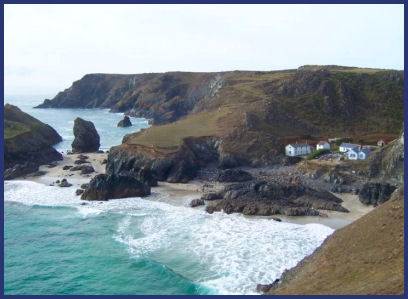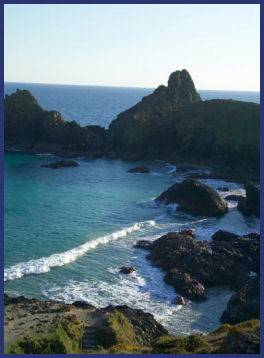Kynance Cove
OS Grid ref:- SW 684133
 Rugged and picturesque Kynance Cove, a designated Area of Outstanding Natual Beauty, is reputed to be one of the loveliest coves in Cornwall and is certainly one of the most photographed locations in the south west of England. The cove is situated just two miles north of Lizard Point, the most southernmost point in mainland Britain.
Rugged and picturesque Kynance Cove, a designated Area of Outstanding Natual Beauty, is reputed to be one of the loveliest coves in Cornwall and is certainly one of the most photographed locations in the south west of England. The cove is situated just two miles north of Lizard Point, the most southernmost point in mainland Britain.
 Kynance Cove is famed for its white sandy beach, clear deep turquoise water, rugged soaring stacks and arches and towering cliffs and has been a popular tourist location since Victorian times.
Kynance Cove is famed for its white sandy beach, clear deep turquoise water, rugged soaring stacks and arches and towering cliffs and has been a popular tourist location since Victorian times.
The Cove is now owned and maintained by the National Trust. The beach is delightful, with caves and rock pools to explore at low tide and there is an award winning cafe serving refreshments in the cove, which first opened for business in 1929.
Until recent years, when taken over by the National Trust, its isolated location meant that the cafe relied on spring water and a generator to supply its electricity. The National Trust provide a reasonably sized car park and toilets which are a ten minute walk from Kynance Cove. The final steps down to the beach are somewhat steep
The area is surrounded by an expanse of heathland containing a profusion of rare wild flowers.The rocks of unique, metamorphic local serpentine around the cove, found in abundance in the area, are so called as they resemble the mottled skin of a snake, they are multi-coloured, with greens, red, yellow and white lines running though them and can be seen clearly at low tide.
The cove's name derives from the Cornish word Kynans which translates as gorge or ravine and there is evidence to suggest that Kynance Cove was occupied by Celtic peoples as early as 300 B.C.. Just off shore lies Asparagus Island, which is so named for the wild asparagus crop that at one time grew in abundance there. The famous Victorian poet, Alfred, Lord Tennyson was one of Kynance Cove's more distinguished visitors.
There are excellent scenic walks along the cliffs in both directions.